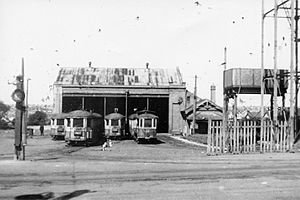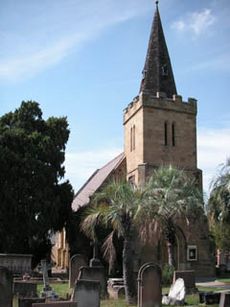Enfield, New South Wales facts for kids
Quick facts for kids EnfieldSydney, New South Wales |
|||||||||||||||
|---|---|---|---|---|---|---|---|---|---|---|---|---|---|---|---|
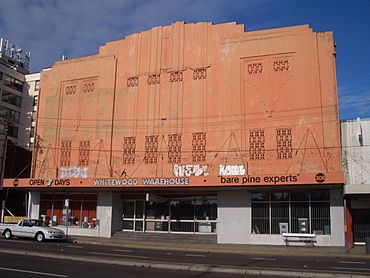
Former theatre on Liverpool Road, in Enfield
|
|||||||||||||||
| Population | 2,833 (2016 census) | ||||||||||||||
| Postcode(s) | 2136 | ||||||||||||||
| Elevation | 42 m (138 ft) | ||||||||||||||
| Location | 11 km (7 mi) from Sydney CBD | ||||||||||||||
| LGA(s) | Municipality of Burwood | ||||||||||||||
| State electorate(s) | Strathfield | ||||||||||||||
| Federal Division(s) | Watson | ||||||||||||||
|
|||||||||||||||
Enfield is a suburb located in the Inner West area of Sydney, New South Wales, Australia. It is about 11 kilometres south-west of the main Sydney city centre. Enfield is part of the Municipality of Burwood, which is a local government area.
Contents
Enfield's Past: A Look at History
The name "Enfield" comes from a suburb called Enfield in London, England.
First People of Enfield: Aboriginal Culture
Before Europeans arrived in 1788, the land where Enfield now stands belonged to the Wangal people. They were a group, or clan, of the Eora tribe. The Eora tribe lived across most of the Sydney area.
Sadly, a disease called smallpox came with the British settlers. This disease greatly affected the Eora people. Many clans became very small, and the survivors had to form new groups. While some Indigenous people fought against the British taking their land, much of the inner-west land was settled by British people within about 30 years.
European Settlement: How Enfield Grew
In 1810, a man named William Faithful was given 100 acres (about 40 hectares) of land. This land included what is now Enfield, plus parts of Croydon Park and Burwood. In 1812, Liverpool Road was built through Faithful's land. Enfield was a good spot for a stop along the road because it was on high ground.
By the mid-1840s, a small village had formed. People in the area grew vegetables and worked in the timber industry. St Thomas's Anglican Church was built in 1848. It is the oldest building still standing in Enfield today.
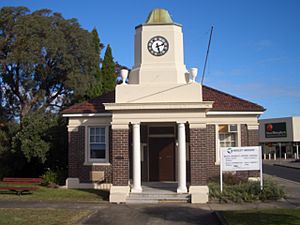
In 1853, a post office was built. This was the first time the name "Enfield" was officially used for the area. In 1889, Enfield was big enough to have its own local council. This council covered a larger area than the suburb of Enfield does today. In 1891, Enfield's population was 2,050 people. This was more than nearby Strathfield and almost as many as Canterbury.
Enfield stayed a separate council until 1949. The NSW state government decided to combine many small councils with their neighbours. The Municipality of Enfield was split up. The eastern part (which is today's Enfield and part of Croydon Park) joined the Municipality of Burwood. The western part (which is now Strathfield South) joined the Municipality of Strathfield.
The Enfield Olympic Pool, located in Henley Park, is Sydney's oldest freshwater pool. It was finished in 1933 and officially opened by Bertram Stevens, who was the NSW Premier at the time.
The Enfield War Memorial is now in Strathfield South. It stands on the corner of Liverpool Road and Coronation Parade. The memorial is a sandstone base with four marble plaques. These plaques have the names of men and women who served in World War I. On top of the memorial is a 105mm French howitzer gun. This gun was given to Australia by the French government to thank Australia for its help in World War I. The memorial was officially opened in 1924.
Enfield's Tram Lines: A Look Back
From 1891 to 1948, Enfield had a tram line. It was based around a tram depot in what is now Croydon Park. The tram line started as a steam tramway in 1891. It ran between Ashfield Station and Enfield.
Over time, the line grew. In 1901, it was extended north through Burwood to Mortlake. In 1909, a branch line opened to Cabarita Park. The tram system was changed to run on electricity in 1912. This tram line was separate from other tram lines in Sydney.
The northern part of Coronation Reserve, a grassy area, sits on top of the old tram tracks. These tracks ran straight north to Liverpool Road. The line also went from Ashfield station.
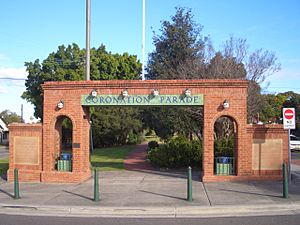
Trams ran from Ashfield Station along Liverpool Road and other streets. They then went north along Coronation Parade, passing the Enfield War Memorial. The line was double track for most of its length. The tram lines closed in 1948 and were replaced by buses.
The road to the east of Coronation Reserve, which is now part of Coronation Parade, was built next to the original tram track. The Coronation Parade Arch was built in 1937 to celebrate the crowning of King George VI. This arch used to lead to the Coronation Parade tram station. The arch has four light bulbs in sockets. These sockets originally held the four electricity cables for the old tram line.
Enfield's Features: What You'll Find Here
Enfield is a small suburb. Its borders are Liverpool Road to the north, Coronation Parade to the west, Mitchell Street to the south, and Burwood Road to the east.
There is a small shopping area along Liverpool Road. It is mainly around the intersection with Coronation Parade and The Boulevarde. You can find larger shopping areas nearby around Strathfield and Burwood train stations.
Because the suburb of Enfield is smaller today than the historical area, some places named "Enfield" are actually in nearby suburbs. For example, the Enfield Intermodal Logistics Centre, a large rail yard, is in Strathfield South. Also, the historic Enfield Town Hall and the war memorial are not in the suburb of Enfield itself.
Places of Worship: Churches in Enfield
- St Joseph's Catholic Church on Liverpool Road was built between 1930 and 1931. Its design was inspired by a church in Paris, France.
- St Thomas's Anglican Church on Coronation Parade was built in 1847. It is designed in a Gothic Revival style and is a very old and important building.
Learning in Enfield: Schools
- Enfield Public School is on Beaumaris Street.
- St Joseph's Primary School is a Catholic school for students from Kindergarten to Year 6. It is located at the corner of Burwood and Liverpool Roads.
Other Interesting Places in Enfield
- Enfield Aquatic Centre (also known as Enfield Olympic Swimming Pool) is a swimming pool run by the local council. It opened in 1933 and is the oldest freshwater swimming pool in Sydney.
- Vision Australia has a centre on Mitchell Street. This organisation helps people who are blind or have low vision.
Getting Around: Transport in Enfield
Liverpool Road is a main road that crosses Coronation Parade and The Boulevarde in Enfield.
Several bus services run through Enfield, operated by Transit Systems and U-Go Mobility. These buses connect Enfield to many other suburbs, including Burwood, Campsie, Sydney Airport, Ashfield, Mortlake, and Strathfield.
Before the 1960s, there was a tram line that ran from Ashfield to Mortlake and Cabarita, passing through Enfield and Burwood. Today, bus services follow a similar route.
People of Enfield: Community and Demographics
Who Lives in Enfield: Demographics
In the 2016 Census, there were 2,833 people living in Enfield.
- About half (49.6%) of the people were born in Australia.
- The next most common countries of birth were China (10.3%) and South Korea (3.9%).
- 40.0% of people spoke only English at home.
- Other languages spoken at home included Mandarin (10.2%), Cantonese (6.9%), Arabic (6.1%), Italian (6.0%), and Korean (5.1%).
- The most common religions were Catholic (35.8%) and No Religion (22.2%).
Famous Faces: Notable Residents of Enfield
- James Anderson (1894–1973): A tennis player who won the Australian Open men's singles title three times (1922, 1924, 1925).
- Gerry Hazlitt (1888–1915): An Australian test cricketer.
- Bob Norton OBE (1922–1992): A former president of the Royal Australasian College of Dental Surgeons. He lived in Enfield when he was a school student.
- Norman 'Wizard' Smith (1890–1958): A racing car driver who held the Australian land speed record in the 1930s.
- Harold Burfield Taylor (1890–1966): A chemist and army officer.
- Bob Windle (born 1944): An Australian swimmer who won an Olympic gold medal in the 1500-metre freestyle at the Tokyo Olympics in 1964.


